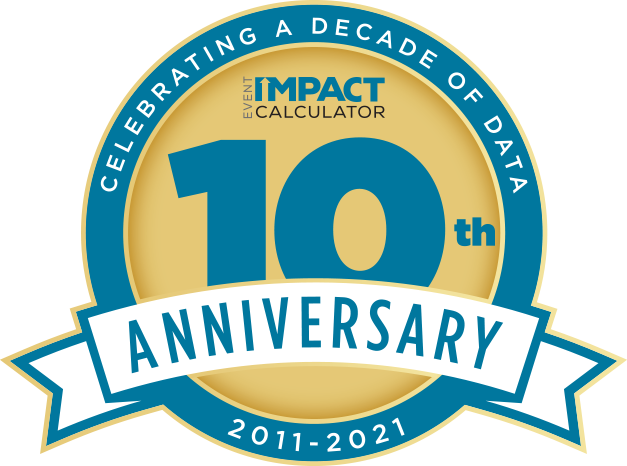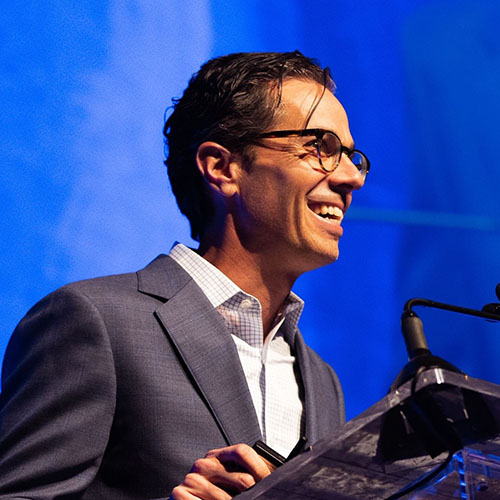by: Elaine Rosquist, CMP, Senior Director of Product Engagement, Destinations International
The Destinations International Event Impact Calculator (EIC) is celebrating a big milestone this year, our 10 Year Anniversary, and we thought what better way to celebrate than to speak with the visionaries behind the tool.

I sat down (via Zoom) with Christine “Shimo” Shimasaki, Managing Director, 2Synergize and Adam Sacks, President, Tourism Economics, and invited Chris Pike, Director, Impact Studies from Tourism Economics to join us. The four of us reminisced about the early days of the EIC, marveled over the tool’s growth, pondered its future, and discussed what it means to the destination marketing industry.
Read on for highlights of our conversation.
Featuring

Managing Director
2Synergize

President
Tourism Economics
Blog: Shimo/Adam interview
The Event Impact Calculator (EIC) is 10 years old but, of course, the idea started before that. Where did the idea begin?
Some of the conversations did start before I had an opportunity to know Adam. It was a full calendar year before we launched, and I remember being in these conversations as I was consulting for Destinations International at the time on several projects. One of these was to facilitate the Convention Sales and Marketing Committee, a brand-new group. Jason Fulvi, from Pittsburgh at the time, was the chair. At the first meeting, the entire conversation became a tirade to fix the economic impact calculation method our industry had been using. We had abandoned any economic impact calculation formula and there was no other solution for the industry and it was a really gaping need.
Around that same time, Tourism Economics had begun working with VisitPittsburgh on a custom calculator and Jason Fulvi and Craig Davis really liked it and saw it as the solution the industry was looking for to standardize this as an approach and to be the successor to ExPact (the solution from the early 2000s). ExPact, of course, was useful in its time but it was a biased sample towards large destinations. It did not measure anything other than total spending; it did not measure event impact in terms of taxes. It was slow to update and super expensive to maintain so, essentially, it was not timely, localized, or comprehensive -- the cornerstones the EIC is based on.
When it comes to reporting on event impact, there was a real desire for standardization for the entire industry and this proved to be that solution. The adoption of a methodology provided the confidence level among destination organizations. We always maintained that event impact was not a comparable measure between destinations but it was the methodology behind it, that consistency, that destination organizations really needed.
Talk about how it took off from there and the partner connections.
From there, we conducted a formalized RFP process and the Sales & Marketing Committee recommended the solution that Tourism Economics was proposing: the Event Impact Calculator, as it became known. This solution was far different from ExPact or a once-every-4-or-5 years expenditure study. The whole notion of having this dynamic tool set us off on a new direction that was greatly needed.
The functionality is why it took off so quickly. It must be credible, localized, and standardized. For instance, New York City would be different from Omaha. So, the approach and data were standardized.
There were a lot of synergies with the team that allowed us to rapidly get right out of the box: between the support of the CSS Committee, because they were willing to provide input and feedback along the way, and working with Adam and team on all the unique possibilities that we needed to get there. We took into consideration how CVBs function and ease of use of the calculator. We also tried to satisfy the research folks and allow them the flexibility to make the calculations more accurate. All those things came about because Adam and team were really listening to the community and willing to make sure we got there with a product that satisfied a wide range of users.
If we were going to have it adopted widely, we needed to make it easy to use. How do you balance out the complexity of what we are trying to measure with a truly transparent and easy to use interface? Working with our developer Digital Mettle, we refined it so that someone on the sales or executive level could go in intuitively with just a little bit of guidance.
And of course, we had support from the DI Foundation from the very beginning. We were launching the development of an idea. They provided the foundational financial support to get the calculator off the ground.
I understand the tool was built around user feedback and collaboration?
For every single Module that we released, starting with Meetings, and continuing with Sports, Festivals, Local Events; every one, Shimo would slow us down and say we are going to create a working group and listen to the end users, so when we get to the end, we will know that it is the right place. Each time, I was struck by how much we learned and, as a result, once we finally launched, it met the needs and answered the questions that we did not know existed. Shimo was that driving force that brought the entire process together, especially during those formative years.
People want to support projects or programs that they have a hand in developing. That has always stuck with me. That type of collaboration does slow us down in many ways, but it pays off in the long run. The EIC, as I know it today, certainly has been a perfect example of that. The CRM vendors that support the DMOs were all willing to jump in to help make the process more seamless. So, we give special thanks to the CRM Vendors; Tempest and Simpleview who were right there with us from the beginning.
Other partners also jumped in with us to make this work. Longwoods International provided data on spending profiles. SMG (now ASM) was a foundational data partner and provided data at no cost; all sorts of norms put a much sharper point on our data. Eventually it all lead the way to the IAVM, SportsETA and now global partnerships.
Today, at our 10 Year Anniversary, we have subscribers in 12 Countries, forty-five US States and nearly three hundred total. What were your initial expectation for interest and adoption?
We dreamed of one hundred.
And then we went in increments of one hundred.
We are now hovering near three hundred and we honestly did not expect that level of adoption. I give a lot of credit to Destinations International’s consistent job to get the message out about what the EIC is and how it helps. Chris and team’s webinars and support have made a big difference.
The calculator helped raise the acumen of how we speak about events. Events drive taxes and support jobs. These are two key talking points that destinations would want to speak about to their local community to continue to support the promotion of attracting meetings and events. The EIC does both fundamentally for them.
Why do you all believe the appetite is so strong for this tool?
These are real decisions destinations are making to host events and it is not free, so knowing the benefits is critical. You cannot make a good decision without that information. The other reason, we have learned increasingly over the last few years, is that Advocacy is a 24/7 operation for a destination organization. EIC is custom built for Advocacy. Each calculation tells the story of “this is what the CVB, through its sales and marketing efforts, has contributed and supported to the local economy in supporting jobs, taxes, and businesses.” It has a dual benefit to help make decisions on hosting events and I really hope destination organizations advocate for the value they are producing. It is encouraging to see how destinations are using the calculations to create messaging around how important their functions are to their local economies.
That was a real issue in the beginning: different methodologies to produce the impact of events. There were many challengers to the calculator; Boston was one. We did dueling calculators with the Boston Convention Center to really understand the MIT version and how did that marry up with EIC and certainly we were at a disadvantage because their solution was localized, and we came out of that experience with a lot of confidence and credibility. We have been open to where those opportunities led us to a calculator growth standpoint and those partnerships with TTRA, IAVM, ECM, etc.
This was meant to be a tool for the DMOs. How have partnerships with SportsETA and IAVM advanced adoption or confidence in the tool?
I look at partnerships as a good sign. People seek you out and want to partner; that is a sign of success. Success breeds success. Those partnerships are important, being able to broaden our lens and DI continuing to nurture partnerships under Don’s leadership has been super important. And there are more partnerships to come to help spur the growth in different directions.
What do you anticipate for the next decade? Where does the tool go from here?
Where does it go from here? If we stay close to the customers and the DMOs, they will tell us where to take the EIC next.
There is a lot of room for growth in the use of the EIC. The stats are encouraging; there is still a lot of need out there, especially for smaller destinations.
Thank you all for your time; it is clear to me that Destinations International and Tourism Economics have been listening to the needs of our members and the EIC is delivering. We look forward to the next “Decade of Data!”

